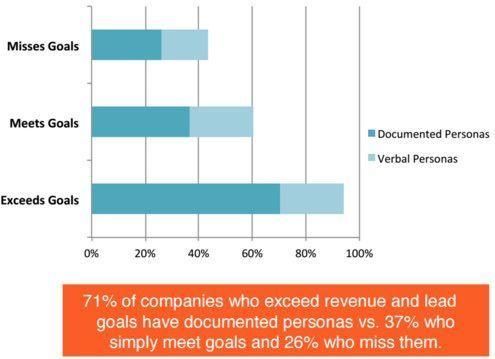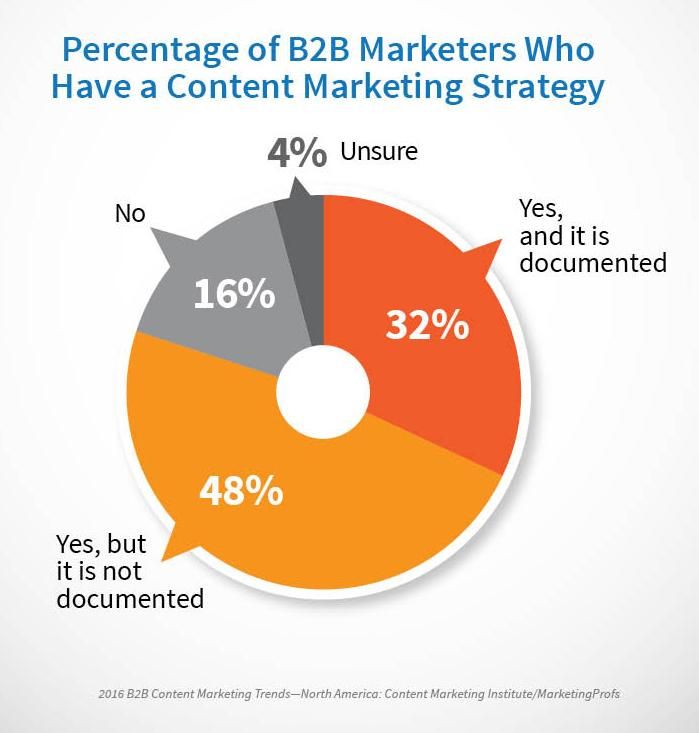While most B2C companies have mastered the art of social media marketing, many B2B companies are still lagging when it comes to adapting effective social media campaigns. But in today’s social media-driven environment, B2Bs can’t afford to slack. Nearly 75% of B2B buyers use social media to make a purchase decision.

I’ve compiled six of my top tips for energizing your B2B social media strategy and boosting your traffic as part of your marketing strategy. I’ll go over:
- How to set realistic and attainable goals for social media
- Creating buyer personas your customers respond to
- Where and how to post on social media for maximum engagement
- Why documenting your social media strategy is a must
- How to draw audience attention through visuals
- And how to build a cohesive brand presence that resonates
Your Guide to B2B Social Media Marketing
How Do You Decide Your Social Media Goals? And How Do You Measure Them?
Before you start posting on social media, you need to define what you want out of your social media strategy. Determine the criteria for success for your brand on social media. Do you want to increase brand awareness? Get more leads? Generate more traffic to your website?
For example, suppose you’re a new company and want to create more brand awareness. In that case, you’ll probably be looking at metrics such as likes, shares, and mentions to evaluate your social media campaigns’ impact.
If your goal is getting more leads, metric you may want to look at include:
- Clicks
- New leads from social media
- Conversions
Determine KPIs
Once you determine your goals, you want to create measurable KPIs. Your KPIs should be specific and include a timeframe. Some common KPIs include:
- Gain 150 more followers on Instagram per month
- Increase social media engagement on Facebook (likes, clicks, shares, and comments) by 20% within 60 days
- Boost blog traffic from social media campaigns by 20% within 30 days
- Increase conversions from social media by 15% within 90 days
Knowing the KPIs you want to reach will help you figure out what actions you need to accomplish them.
Determine How to Track KPIs
Once you figure out your goals and the KPIs you’ll use to measure them, make sure you’re using a social media analytics platform to track performance. There are all kinds of tools available on the market for tracking social media metrics, including:
- Google Analytics shows you what social media platforms bring the most visitors to your site and conversions from your posts.
- HubSpot Social, which monitors how often people mention your brand and user engagement on social media. Hubspot Social can compare your campaigns’ performance on different social sites and show you the best time to publish content.
- CoSchedule tracks your social posts’ performance with in-depth reports and recommends the best content to post and when to post it.
- BuzzSumo shows your most shared posts on social media and helps you find the top influencers in your industry.
Understand Your Audience
In a previous blog, I mentioned that your company values should be your customer’s values, and social media is no different. Your social media strategy should revolve around what your audience finds valuable. Social listening allows you to find your customers’ conversations and is the best way to discover key audience insights.
Here are some tips on how to tap into your customers’ conversations.
Competitors
It’s a no-brainer that your competitor’s audience is similar to yours. See how your competitors are engaging with customers online. Discover the kinds of conversations surrounding the competitor in their communities. What do people most like and dislike about the competing company? You can leverage this information in your social media campaigns. For example, if there are repeated complaints about the competitor’s service, you can build your social media presence on being “professional and helpful.”
Influencers
Influencers are thought-leaders in your industry with large followings. Keep an eye out for conversations influencers have with your audience to get information on new developments and trends in your industry.
Keywords
Make a list of industry-related keywords and track and follow conversations around your brand. You’ll discover more about your customers’ interests and motivations. As mentioned briefly in the previous section, platforms like Hubspot Social, BuzzSumo, and CoSchedule can help you manage this and other social listening tasks.
Hashtags
Monitor brand-related hashtags. If you find your business or products aren’t mentioned at all, it’s a signal you need to increase brand awareness.
Create Buyer Personas
Social listening is good for another reason. You need to know your customers’ likes and dislikes to create useful buyer personas. Research shows that 71% of companies who exceed revenue and lead goals have documented buyer personas.

There’s a lot of advice on building effective buyer personas, but I found this method the simplest. Analyze the social media profiles of business managers who already purchased your product or service. They represent customer groups and help you understand your target market.
You can keep track of their information in Excel by listing their names, contact information, and social profiles. If you can find it, also list other demographics such as age, position, industry, and business size.
Understanding the people who have already shown interest in your products and building social campaigns around them will boost clicks and engagements on your social media campaigns.
Identify Social Media Platforms
Social listening tools and buyer personas should have given you a head-start on finding your customers’ social media platforms. Still, some social media platforms are more suited for B2B activities than others. I’ll list a few here:
- LinkedIn is the most well-known B2B social site and the most popular among Fortune 500 companies. LinkedIn is the #1 platform used by B2B marketers and makes up over half of all social traffic for B2B blogs and websites.
- Twitter is the second most popular site for B2B businesses, and the next place marketing executives go to after LinkedIn to find good content.
- YouTube is fast becoming popular with B2B companies, with nearly 60% of B2B marketers using the platform to distribute content. Youtube is one of the most effective B2B advertising channels after email marketing, LinkedIn, and print advertising.
These top three social media sites are a good starting point for your B2B social media strategy. However, there are other social media platforms you should look into like Reddit, Pinterest, and Quora.
Create a Written Strategy
Now that you know your goals, audience, and the social media platforms you intend to use, draft a written plan. A formal plan is one area where B2B marketers are generally failing. While many B2B companies have a social media strategy, many take a seat-of-the-pants stance on execution. 80% of B2B companies have a social media strategy, but only 32% have a documented plan.

Keeping a document of your social media plan not only allows you to set a roadmap for your goals, but it also allows other people in your company to implement it. Your social media plan should answer the following:
- What are your social media goals?
- How will you measure them?
- What are your KPIs?
- Who is your target audience?
- How are your competitors using social media?
- What social platforms are you using?
- What content will you publish?
Take time to write and document your social strategy. A written social media strategy keeps everyone on the same page and allows you to make quick adjustments.
Create Content for Social Media
Creating content is the meat of an excellent social strategy. Some best practices to keep in mind include:
- Establish thought-leadership by responding to news and trending topics in your industry. The best way to do this is to follow popular and current companies and figureheads within your industry. Having conversations with industry influencers gives your platform more credibility.
- The more visuals you have, the better. Social media with multimedia elements should have the highest rates of engagement. Be sure to post infographics, images, videos, and memes.
- Different buyer personas need different content. Customers at the discovery stage of the buyer’s journey will need different content than customers in the decision stage. You can’t take a one-size-fits-all approach to content. You want to make sure you’re reaching customers with quality content at every touchpoint in their journey.
- Have a healthy mix of TOFU (top of the funnel) and BOFU (bottom of the funnel) content. TOFU content are things like short videos and infographics that educate buyers. BOFU content are things like product comparisons and user-generated content, such as testimonials.
- Find the best times to post with experimentation. The consensus is that the best times to post on social media are Monday – Friday from 10 a.m. to 3 p.m. However, every audience is different, test to see what fits well with your target demographic. Post at least once per day for maximum engagement.
- Celebrate your team members and partners. The human interest type of social media posts helps customers more easily relate to your company. You can post employee accomplishments, interviews with experts, and behind the scenes videos from company events.
- You don’t always have to come up with your content. Reshare content from reputable third-party sites that’s related to your industry. Research shows people respond the best when third-party links are shared 50 to 75% of the time, and original content 25 to 50% of the time. Share a mix of curated content from top industry sources and original content like your blog posts, ebooks, white papers, product videos, and webinars.
Maintain Consistency
I’d be remiss if I don’t share this vital point of a social media strategy: consistency is critical.
I’m not only talking about posting consistently, but your presence online needs to look cohesive. You need to maintain a uniform look and feel so that people can recognize you online. You also need to post often enough to reach the maximum number of people, so you don’t always have to come out of pocket paying for ads or post boosts.
Consistency is not as easy as it looks. Altimeter discovered that 70% of marketers lack a posting and visual consistency in their marketing strategy.
Most B2B businesses fail at this because they do not regularly publish new content. According to Joe Pulizzi, founder of Content Marketing Institute, consistency in this context means posting at the same time on the same days for a year or more.
Building a brand style guide can help. It offers you and your team members details of how your brand should look and feel across all social platforms. Brand style guides also include details on posting frequency so that you and your team can consistently grow your profile.
Closing Thoughts
To wrap up, the keys to a successful social media plan include:
- Set your goals and KPIs
- Understand your audience
- Post on the right social media sites for you
- Document your social media plan
- Have a compelling mix of visual content
- Maintain a consistent look and posting schedule
After you planned your strategy, it’s time to monitor how you performed. Did you reach your goals? Carefully track things like engagement, follower count, shares, and conversions to plan your next campaign. If you didn’t reach your goals, look at where you came up short and decide what needs to be tweaked to make your social media strategy better.
With a B2B social media strategy, it’s easier to reach your goals, boost sales, and ensure your company’s success for years to come. And, by using proper monitoring tools, you can continuously adjust your strategy to make sure it continues performing effectively and is finding your audience.


